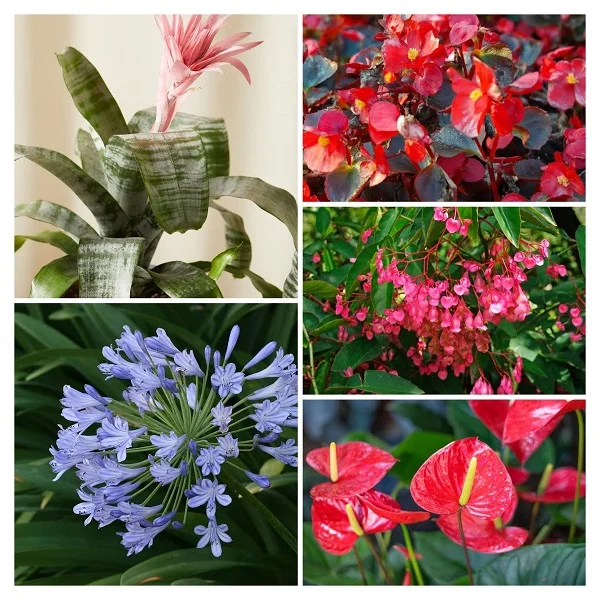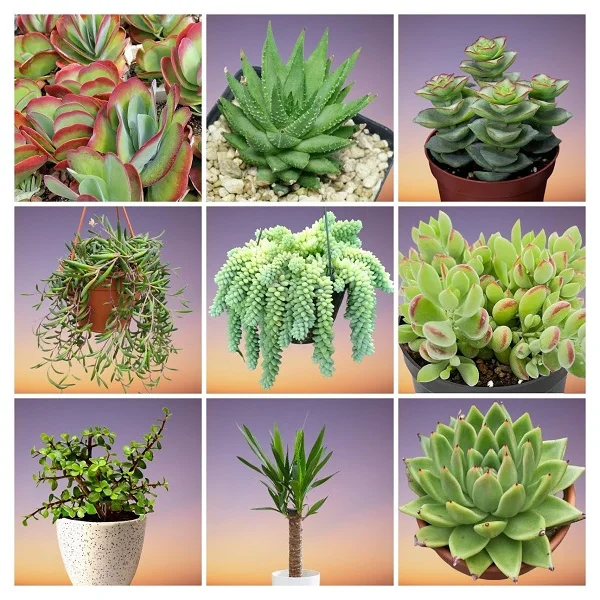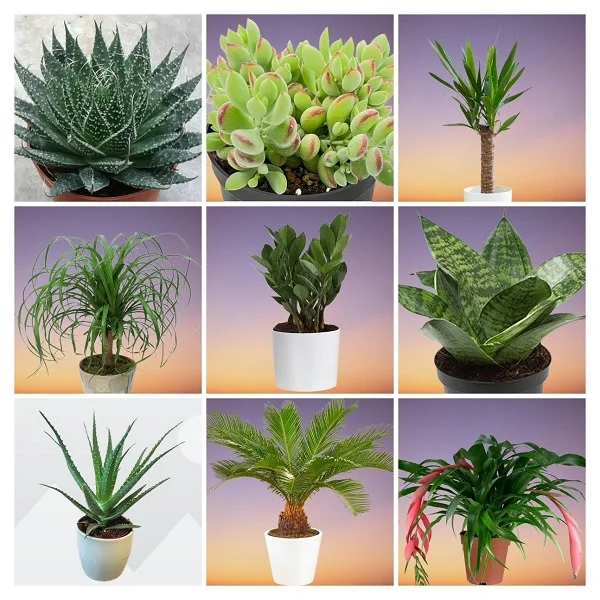Trailing Kalanchoe (Kalanchoe uniflora) Indoor Care, Propagation and Common Problems
Some links in this post may be affiliate links
Trailing Kalanchoe (Kalanchoe uniflora) blossoms in bright light with some direct sunlight, moderate warmth average humidity and moderately moist, rich, loose, free-draining soil coupled with fortnightly feeding in the growing season.
Kalanchoe uniflora also called Coral Bells, Coral Berry or Winter Bells is one of the climbing Kalanchoe varieties and bears fleshy, bright-green leaves and bright red to red-violet, bell-shaped flowers.
Coral Bells provides a spectacular display in a hanging basket or on a pedestal where the pendulous stems and colorful flowers can hang down beautifully. It is one of the best flowering plants for a hanging basket.
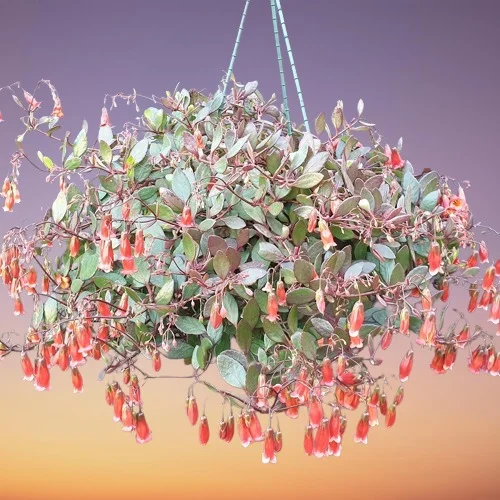
Botanical name: Kalanchoe uniflora
Family: Crassulaceae
Common names: Trailing Kalanchoe, Coral Bells, Coral Berry, Winter Bells
Origin
Kalanchoe uniflora (Trailing Kalanchoe) is native to Madagascar.
Flowers
The flowers in Coral Berry are bright red to red-violet, bell-shaped and appear in winter.
Size
Winter Bells is a trailing plant whose stems can reach upto 3 feet long. It is among the best hanging succulents for indoors.
Toxicity
The American Society for the Prevention of Cruelty to Animals (ASPCA) has listed Kalanchoe Plants as toxic to animals. They contain Calcium glycosides which are toxic to animals. Keep the plants away from the reach of children and pets to avoid any mishaps.
Where to Buy
Trailing Kalanchoe are a great addition to any collection. You may acquire these plants online from Etsy (Link to Etsy).
Kalanchoe uniflora Care Indoors
Trailing Kalanchoe (Kalanchoe uniflora) blooms in bright light with some 4-6 hours of direct sunlight, moderate warmth of 18-280C, average humidity of 50-55% and moderately moist, fertile, loose, free-draining, succulents potting soil coupled with fortnightly feeding during the growing season.
Kalanchoe uniflora requires annual repotting at the beginning of the growing season. Pruning is needed to keep it neat as well as promote flowering. Keep on reading for more on these growing conditions and how to achieve them.
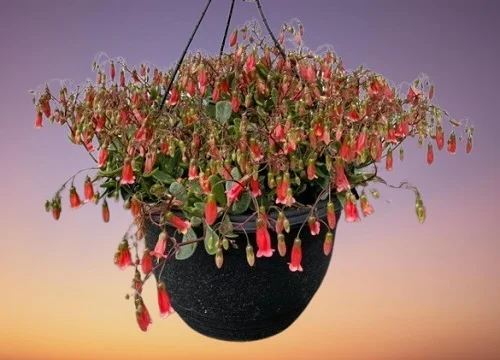
Light Requirements
Trailing Kalanchoe grows best in bright light with at least 4-6 hours of direct sunshine per day to encourage flowering.
If light is not enough, it will become leggy with wide spaces between the leaf and will not bloom. Where the natural lighting is not sufficient, you may grow Kalanchoe uniflora under a grow light. Check out these full spectrum grow lights on Amazon.
Turn the pot regularly to ensure the plant receives light on all sides for even growth and prevent legginess.
Watering
Water Trailing Kalanchoe thoroughly during the growing season and allow the top 2-3 inches of soil to dry out between waterings to keep the soil moderately moist.
Cut down on watering during the cold period to maintain the soil almost dry but do not allow the soil to dry out completely.
Make sure that the pot has a drainage hole and drain excess water from the saucer to prevent the soil from getting soggy as it can lead to rotting and death of the plant.
To avoid shocking this tropical plant which can result in reduced growth, water the Coral Bells with tepid water (water that is at room temperature).
Temperature and Humidity
Average warmth of 18-280C is ideal for Trailing Kalanchoe. Keep it away from cold drafts to avoid sudden drops in temperature as they can cause leaf drop.
Trailing Kalanchoe has no need for extra humidity. Average room humidity of 50-55% is adequate for this plant. Clean the leaves by wiping with a damp soft cloth to get rid of dust and discourage pest and disease infestations. Make sure that there is good air circulation to prevent fungal diseases.
Potting Soil
The best soil for Trailing Kalanchoe should be rich in organic matter, loose and free-draining to avoid getting soggy soil. The soil should be loose enough to allow water to drain out fast enough. Cactus and succulents potting mix is ideal for the plant.
Fertilizer
Feed Trailing Kalanchoe with a phosphorous-rich, water-soluble fertilizer every 2 weeks when the plant during the growing period to promote flowering. Do not feed in the cold season as the plant is in the dormant stage and feeding at this time can lead to fertilizer burn and death of the plant.
Repotting
Repot Trailing Kalanchoe every year after the rest period (cold season). Use a clay pot one size larger than the current one. Ensure that the pot has a drainage hole to prevent the soil from getting soggy as it can lead to root-rot disease and eventual loss of the plant. Do not repot a plant that is in flower as the repotting shock can shorten the flowering period. Take a look at these pots with multi mesh drainage holes on Amazon.
Pruning
Pruning Trailing Kalanchoe involves removal of dead flowers to maintain the plant tidy. Prune the tops after flowering is over and place the pot in a shaded place. Keep the soil almost dry for a month and then position the plant in a spot with bright light and water normally. Doing this will initiate more flowering.
How to Force Trailing Kalanchoe to Rebloom
Trailing Kalanchoe is a short day plant. This means that it requires a rest period of short days for 6 weeks to hasten flower bud formation.
To achieve this, place the Coral Bells in a dark cupboard or cover it with an opaque cardbox for 14 hours per day for 6 weeks. Alternate this with bright light for 10 hours per day during this period.
Keep the plant warm, away from draughts and do not feed or water it during this rest period.
When the flower buds appear, at the end of the 6 weeks rest period, move the plant to a brightly lit place, water and feed it, and resume routine care.
Using this method, you can trick the Trailing Kalanchoe to bloom at any time of the year.
Propagation
Trailing Kalanchoe (Kalanchoe uniflora) can be propagated at the beginning of the growing season from stem-tip cuttings or leaf cuttings.
How to propagate Trailing Kalanchoe from stem-tips cuttings
Take a stem-tip cutting of about 4-6 inches from a healthy Trailing Kalanchoe. Ensure each cutting has 2-3 leaf nodes as this is where new growth will come from.
Strip off the lower leaves and allow the cutting to dry (callus) for 1-3 days before planting to prevent rotting.
Insert the stem-tip cutting into moist, free-draining soil and ensure the pot has a drainage hole to prevent the soil from getting soggy as it can lead to rotting.
Cover the set up with transparent polythene to raise humidity inorder to hasten rooting and establishment.
Place the set up in a warm, brightly-lit place and maintain the soil moderately moist through out.
Allow the new Coral Bells to be well established before transplanting after which routine care can begin.
How to propagate Trailing Kalanchoe from leaf cuttings
Take a leaf cutting from a healthy Trailing Kalanchoe. Ensure that the petiole is intact as this is where new growth will emerge from.
Allow the cutting to dry (callus) for 1-3 days before planting to prevent rotting.
Insert the cutting's leaf petiole into moist, free-draining soil while ensuring that the leaf midrib also comes into contact with the soil.
Confirm that the pot has a drainage hole to prevent the soil from getting soggy as it can lead to rotting.
Cover the set up with transparent polythene to raise humidity inorder to hasten rooting and establishment.
Position the set up in a warm, brightly-lit place and maintain the soil moist through out but not soggy.
Once the plantlets have grown at least one set of leaves, carefully seperate them and pot in individual pots.
Place the new Coral Bells in a warm, well-lit spot after which routine care can begin.
Related: 5 Easy Ways to Propagate Kalanchoe (Kalanchoe Propagation)
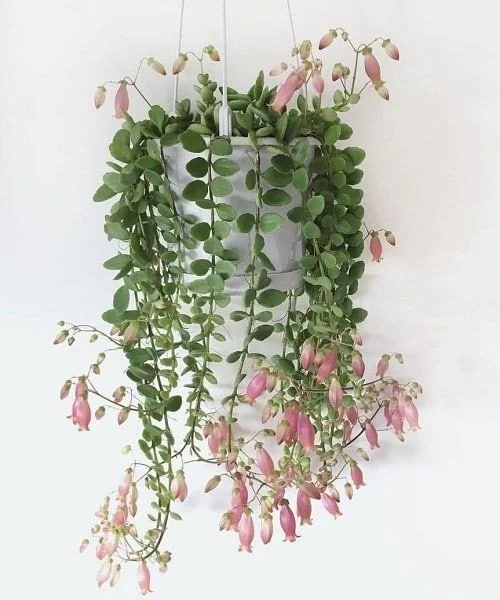
Trailing Kalanchoe Problems
Trailing Kalanchoe (Kalanchoe uniflora) problems include drooping leaves, leaf drop, leggy growth, leaf spots, lack of blooms, pests and diseases among others. Read on for more on these problems and how to solve them.
Pests
Trailing Kalanchoe is prone to mealybugs, spidermites, scale insects and aphids. Isolate the affected plant to avoid spread to the other plants and treat it with insecticidal soap as per the manufacturer's instructions.
Brown soft leaf spots
Trailing Kalanchoe brown soft leaf spots is an indication of leaf spot disease which is enhanced by wet conditions and poor air circulation. Avoid wetting the foliage or water from the bottom and ensure that there is free air circulation at all times. Read more on how to treat leaf spot disease in houseplants.
Moldy leaves and flowers
Moldy leaves and flowers in Trailing Kalanchoe are an indication of powdery mildew which is enhanced by overwet conditions coupled with poor air circulation. Cut off the diseased parts and keep the plant warm while ensuring that there is good air circulation. Do not mist or wet the plant as moisture on the foliage creates ideal conditions for this disease. Isolate the affected plant and treat it with neem oil as per the manufacturer's recommendations.
Lack of blooms
The are three possible reasons for lack of blooms in Trailing Kalanchoe. One possible reason for lack of blooms is too little light. Move the plant to a brighter spot where it will receive bright light with at least 4-6 hours of sunshine per day or instal a grow light where the natural lighting is inadequate. Check out this guide on understanding light for houseplants.
The second possible reason for lack of blooms in Trailing Kalanchoe is feeding it with a nitrogen-rich fertilizer which promotes foliage growth at the expense of flowering. Feed the plant with a phosphorous-rich, water-soluble fertilizer every 2 weeks during the growing season to promote flowering. Learn how to feed houseplants.
The third possible reason for lack of blooms in Coral Berry is underwatering. Water the plant thoroughly during the growing season and allow the top 2-3 inches of soil to dry out between waterings. Decrease watering during the cold season as growth is reduced at this time to maintain the soil slightly moist but do not let the soil dry out completely. Read more on how to water houseplants the correct way.
Drooping leaves
Trailing Kalanchoe drooping leaves is due to underwatering. Immediately water the plant thoroughly and it should recover. Thereafter, water the plant thoroughly during the growing season while allowing the top 2-3 inches of soil to dry out between waterings. In the cold season, water the plant very infrequently but never allow the soil to dry out completely.
Leaf drop
Trailing Kalanchoe leaf drop is due to watering it with very cold water which has caused shock to the plant. Water the plant with tepid water (water that is at room temperature) to avoid plant shock for this tropical plant.
Underwatering is another reason why Coral Bells is losing leaves. Water the plant thoroughly and allow the top 2-3 inches of soil to dry out between waterings to keep the soil moderately moist. Reduce watering during the cold months and maintain the soil almost dry but never allow the soil to dry out completely.
Leggy stems
Trailing Kalanchoe leggy stems are caused by two possible reasons. One reason for leggy stems is overwatering during the cold season. Significantly reduce watering in the cold season as growth is reduced at this time and maintain the soil almost dry.
The second reason for Coral Bells leggy stems is too little light during the growing season. Position the plant in a brighter spot and ensure it is receiving bright light with at least 4-6 hours of sunshine per day or instal a grow light if the natural lighting is not enough.
Wilted and discolored leaves
Trailing Kalanchoe wilted and discolored leaves are due to soggy soil brought about by overwatering or too much water in the soil during the cold period. Lessen watering in the cold season and maintain the soil almost dry. In addition, make sure that the pot has a drainage hole and that the soil drains easily to prevent it from getting soggy.
Brown dry leaf spots
Trailing Kalanchoe brown dry leaf spots are due to underwatering during the growing season. Water the plant liberally during the growing period while allowing the top 2-3 in. of soil to dry out between waterings to keep the soil moderately moist. Never allow the soil to dry out completely.
You liked it? Share on social media.
Related Content
Amazon Associates Disclosure
Homeplantsguide.com is a participant in the Amazon Services LLC Associates Program, an affiliate advertising program designed to provide a means for sites to earn advertising fees by advertising and linking to amazon.com.



